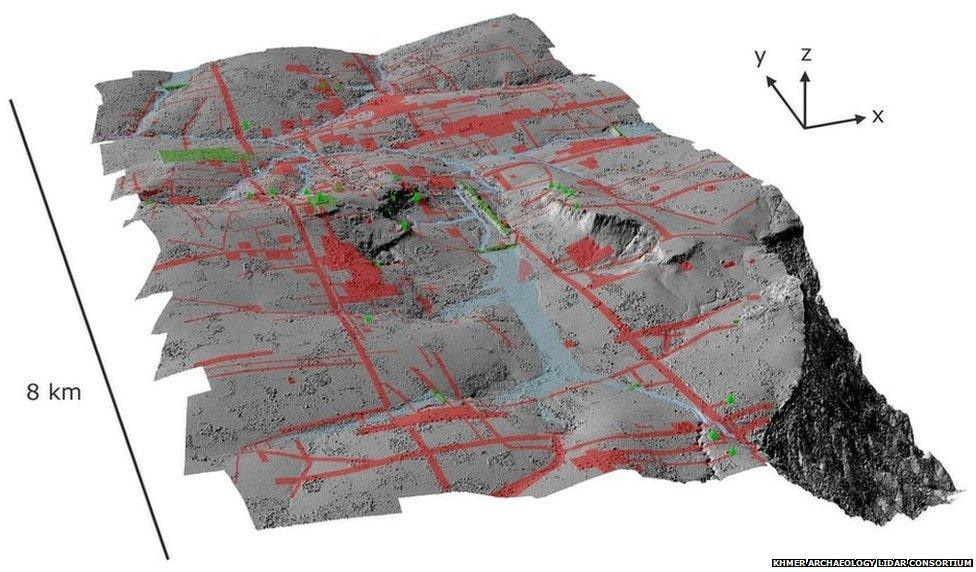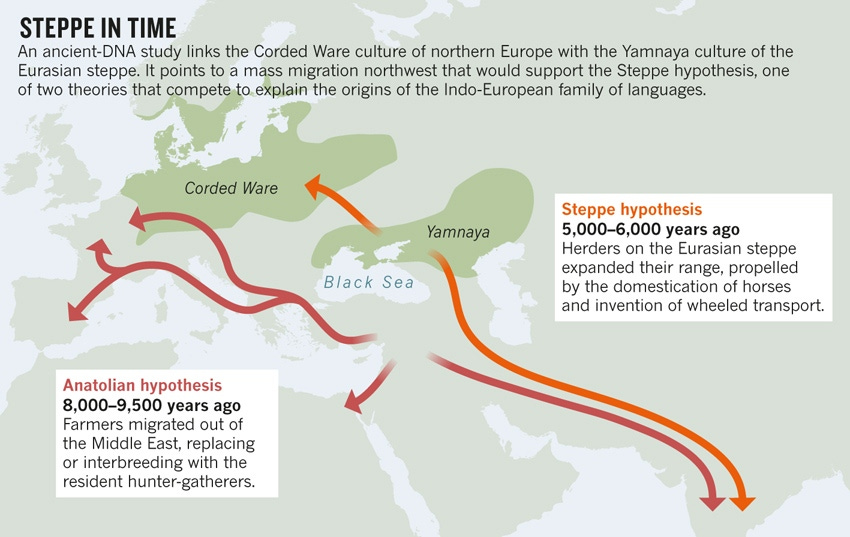AI and the Beginning of History
How AI, in conjunction with other technologies is completely rewriting history and bringing the past closer.
The default view of most technologies is to imagine what the future looks like because of them. What if we do the opposite? What does the past look like in the AI era? Three technologies are completely rewriting and expanding our view of history, paradoxically bringing the future much closer to the past and allowing us to learn from it, from how societies prospered and failed and how we are vulnerable to and can protect ourselves from natural disasters and disease. AI plays a role in accelerating all three.
The future is bringing the past closer.
1. LiDAR
LiDAR (Light Detection and Ranging) works by emitting rapid laser pulses from an airborne sensor which bounce off the earth’s surface. By calculating the time it takes for each pulse to return, LiDAR generates high-resolution 3D models of the terrain, even through dense vegetation or jungle canopy. When paired with AI algorithms trained to recognize anthropogenic patterns, such as rectilinear geometry, alignments, or elevation anomalies, LiDAR can automate the detection of archaeological features across vast, previously inaccessible landscapes. This fusion of remote sensing and machine learning is enabling archaeologists to shift from exploratory fieldwork to targeted verification, dramatically accelerating site discovery and interpretation.
LiDAR has profoundly reshaped our understanding of the Maya civilization, challenging earlier views that depicted it as a collection of loosely connected city-states in a sparsely populated rainforest. Before LiDAR, archaeologists relied on ground surveys that were limited by dense jungle cover. However, airborne LiDAR scans over the Petén Basin in Guatemala revealed more than 60,000 previously unknown structures, including temples, causeways, defensive walls, and complex agricultural terraces. These findings pointed to a highly organized and urbanized society with dense population centers and a vast transportation network connecting cities. The scale and coordination implied by these features suggest that the Maya were not only more populous (possibly 10–11 million people) but also more politically unified and militarized than scholars had previously thought.
In the Amazon Basin, LiDAR has overturned the long-standing myth that it was an untouched wilderness inhabited by small, nomadic tribes. Previously, academics believed that poor soils and a lack of infrastructure precluded the development of complex societies. But recent scans have revealed geometric earthworks, ceremonial platforms, causeways, and raised fields that extend across Acre, Brazil, and the Llanos de Mojos in Bolivia. These settlements, some dating back over 2,000 years, demonstrate large-scale landscape engineering and organized planning. Combined with discoveries of biochar-like manmade soil capable of supporting intensive agriculture, the evidence indicates that the Amazon was once home to populous, sophisticated cultures whose legacy had been largely erased by depopulation and forest regrowth.

In Cambodia, the city of Angkor, capital of the Khmer Empire, was also radically reinterpreted thanks to LiDAR. Previously, Angkor was thought to be primarily a ceremonial complex surrounded by scattered settlements, and its decline attributed to sudden ecological or military collapse. However, LiDAR surveys conducted between 2012 and 2015 revealed a sprawling urban infrastructure covering more than 1,000 square kilometers, with structured road grids, canals, reservoirs, and habitation mounds. These findings show that Angkor was not just a religious center but a fully-fledged low-density metropolis, supported by sophisticated water management systems that regulated floodwaters and enabled agriculture. Rather than a sudden collapse, the new data supports a gradual decline driven by environmental, economic, and social change.
Elsewhere in mainland Southeast Asia, LiDAR has revealed extensive early urbanism that had been overlooked due to forest cover and later development. Sites like Mahendraparvata and Longvek in Cambodia, once thought to be isolated or peripheral, were shown to have dense grids of roads, embankments, and habitation platforms, dating back several centuries earlier than previously believed. These challenged the traditional narrative that Southeast Asian urbanism was late to develop and heavily derivative of Indian or Chinese models. Instead, LiDAR evidence points to independently developed forms of urban planning, hydraulic engineering, and political organization. These discoveries affirm that early Southeast Asian civilizations were capable of large-scale, indigenous complexity.
LiDAR’s biggest impact lies not just in the discovery of individual sites but since it operates over large areas all at once, its major rewriting of history has been in the reinterpretation of entire civilizational narratives, showing that many ancient societies were larger, more organized, and more resilient than traditional archaeology ever suggested.
2. AI Decryption
AI decryption leverages machine learning trained on large corpora of historical scripts, in order to interpret ancient texts that were previously illegible, damaged, or inaccessible. At its core, it combines advanced imaging with pattern recognition algorithms that can identify ink traces, character shapes and writing structures. By comparing features across known and unknown scripts, AI can infer missing parts, segment text into readable lines, and translate them with increasing accuracy. Crucially, AI can operate on fragile or unopened artifacts such as carbonized scrolls, to virtually unroll them, without disintegrating.

The most famous examples of AI decryption are the Herculaneum papyri, a library of over 1,800 carbonized scrolls buried by the eruption of Mount Vesuvius in 79 AD. For centuries, these scrolls were thought unreadable due to their extreme fragility. But last year, using a combination of CT scans and AI segmentation algorithms, researchers managed to decode previously invisible Greek letters from inside unopened scrolls. They revealed substantial portions of works by the Epicurean philosopher Philodemus, including his treatise On Vices. Fully decoding the Herculaneum library alone could potentially double the number of Ancient Greek or Roman texts.
Beyond Herculaneum, AI is beginning to revolutionize our understanding of ancient scripts and languages worldwide. AI models have been applied to partially decipher Linear B and Mayan glyphs, helping accelerate interpretations that once took decades. In Mesopotamia, researchers are developing tools to scan and classify thousands of clay tablets, some still untranslated, using natural language processing tailored to Akkadian and Sumerian syntax. Similar efforts are underway with Aramaic inscriptions, Dead Sea Scroll fragments, and even undeciphered scripts like the Indus Valley seals, where AI might detect repeated structures or semantic groupings beyond human perception. As training data expands and models become more sophisticated, they could help resolve longstanding mysteries about the structure and operation of early civilizations.
3. Ancient DNA
Ancient DNA (aDNA) is one of the most disruptive scientific tools to emerge in the last two decades, offering window into the deep past that has overturned, revised, and sometimes outright invalidated centuries of archaeological and historical consensus, overnight. Ancient DNA analysis only became viable in the early 2000s with breakthroughs in high-throughput sequencing and contamination control, allowing researchers to extract and analyze fragments of DNA from ancient bones, teeth, and sediments, sometimes more than 50,000 years old. By comparing ancient genomes to modern populations, scientists can reconstruct not just individual lineages but entire patterns of migration, disease and ethnicity. Unlike traditional archaeology, which often relies on material culture or linguistic inference, aDNA offers direct, incontrovertible biological evidence which is frequently a narrative violation.
AI is now essential in ancient DNA research, used to clean and reconstruct degraded genetic sequences, identify contamination, and correct damage typical of ancient samples. Machine learning models detect patterns of ancestry, migration, and interbreeding by clustering genomes and modeling admixture events, even from low-quality data. AI also helps identify functional gene variants—like those affecting immunity or lactose tolerance—and tracks how they evolved.
Ancient DNA is redefining identity. In places like Britain, aDNA has shown that the Beaker people, who arrived around 2400 BCE, replaced about 90% of the island’s existing population (the Stonehenge builders) within a few centuries, suggesting that continuity between prehistoric and modern Britons is far weaker than once believed. In Egypt, aDNA studies from mummies revealed dominant ancestry from the near East (e.g. Mesopotamia) during the New Kingdom. In India, ancient genomes have added fuel to debates around the Aryan migration, suggesting substantial population shifts during the Bronze Age that coincide with the spread of Indo-European languages, challenging both colonial-era and nationalist interpretations.

One of the most profound impacts of aDNA has been the rewriting of European prehistory. For decades, the dominant archaeological model held that the spread of agriculture into Europe was a cultural diffusion: ideas moving from the Near East, not people. Ancient DNA shattered this notion. Starting with studies around 2010, genome-wide analysis showed that early European farmers were genetically distinct from local hunter-gatherers, having migrated en masse from Anatolia. Later, around 2500 BCE, another massive genetic shift occurred with the arrival of Yamnaya steppe pastoralists (from around modern day Ukraine), bringing Indo-European languages, horses, and a patrilineal social order. This genetic turnover was so profound that in many parts of Europe, over 90% of the male lineages were replaced. These findings overturned more than a century of archaeological orthodoxy and introduced a new, more dynamic and more violent view of Europe’s formation.
Even more profound, aDNA has also begun to challenge the model of global human history, challenging the Out of Africa model of human origins in its traditional form and showing it to be much more complex and not a single event in either direction. While the genetic consensus still supports a primary African origin for Homo sapiens, recent sequencing of archaic human DNA suggest a far more complex and messy genealogy than previously thought, more like a web than a family tree. Findings show possible gene flow back into Africa from Eurasian populations and evidence that archaic admixture may have contributed crucial immune and environmental adaptations. The story of human origins involves multiple migrations, interbreeding, and feedback loops.
Most dramatic of all, Ancient DNA has literally reshaped how we understand what it means to be human. The discovery of Neanderthal interbreeding with Homo sapiens was one of the earliest and most paradigm-shifting breakthroughs of ancient DNA research. Until 2010, the dominant view in paleoanthropology was that Neanderthals were a separate, extinct hominin species that died out without contributing to the modern human gene pool. But when a team at the Max Planck Institute sequenced the first draft of the Neanderthal genome, they found that all non-African humans today share approximately 1–4% of their DNA with Neanderthals. This conclusively proved that interbreeding occurred after modern humans left Africa and encountered Neanderthals in Europe and western Asia around 50,000–60,000 years ago. Further analysis also uncovered interbreeding with Denisovans, a previously unknown hominin group identified entirely through DNA, into populations in Oceania and parts of Asia. These findings fundamentally rewrote the story of human evolution, replacing the clean “replacement” model of Homo sapiens’ rise with a complex one of interbreeding and interaction between multiple hominid groups.
The Future of History
AI decryption, LiDAR, and ancient DNA are rewriting history by revealing hard data where only speculation existed. AI decryption is likely to double our knowledge of Roman philosophy and literature. LiDAR is uncovering vast pre-Columbian cities in the Amazon and previously unknown infrastructure around Angkor, forcing a re-evaluation of how complex ancient societies were. Ancient DNA is settling debates on migration and ancestry, showing massive population replacements in Europe and interbreeding with Neanderthals and Denisovans.
The AI future will uncover what is in our landscape, our myths and in our bones. It will bring the past closer, discover lost civilizations and texts, while ancient DNA will create a comprehensive prehistory of the world before writing existed.

